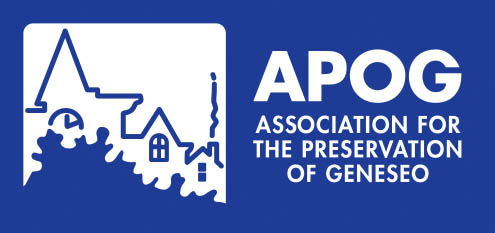Veterans' Memorials
Memorial to the Veterans of the Civil War
Courtesy of Livingston County Historian
Geneseo's two memorials honoring the men who have given their lives in war are at opposite ends of the village. At the north end of Main Street the Civil War Monument in front of St. Mary's Church is an imposing 40' granite shaft given by the Hon. James W. Wadsworth, Sr., in 1915. At the south end of the street and overlooking the Village Park is the Veterans' Memorial erected in 1955.
Decoration Day was first observed in Geneseo on Saturday, May 29, 1869. Due largely to the urging of Professor J. Jones of the Geneseo Academy, a meeting was held where “it was unanimously resolved that the ceremony of decorating the graves of the Union soldiers shall take place….” Accordingly, on the day set aside the bells of all the churches were rung at 2:30 p.m. At 3 o'clock the citizens assembled on the grounds of Temple Hill Academy to participate in the program. After a prayer and music by the Mt. Morris Brass Band the procession was formed and marched to the cemetery. At each of the nineteen graves the procession halted, a bouquet was placed and the name and regiment of the deceased Union soldier announced. Returning to the grounds of the Academy, formal exercises were held under her stately trees. The ceremony was judged so impressive that a committee was formed to make arrangements to repeat it the next year.
Decoration Day in l870 was conducted on a larger scale. The procession formed at the corner of Main and Center Streets, the formation being such that there was a place for every citizen who wished to participate. Heading down Main to North Street the line of march moved across Second to Elm, on to South and then to Temple Hill Cemetery. At this time the graves, which were decorated with beautiful fresh flowers, included those of all who had fallen in battle. Not overlooked was the grave of William Tyler, a Revolutionary War soldier who died in 1834 and who was at West Point when Benedict Arnold escaped. Moving on to St. Mary's Cemetery the graves of the Roman Catholic soldiers were likewise honored. Exercises were again held on the Academy grounds and the program included a poem, “The Bard of Avon,” written by Col. W.H.C. Hosmer. The last stanza reads as follows:
Tongues whisper that my funeral lay
Should into echo die away.
Our fallen chivalry require
No dirge notes from a shattered lyre
For on fame's cloud-capped column high
Their names will blaze eternally.




